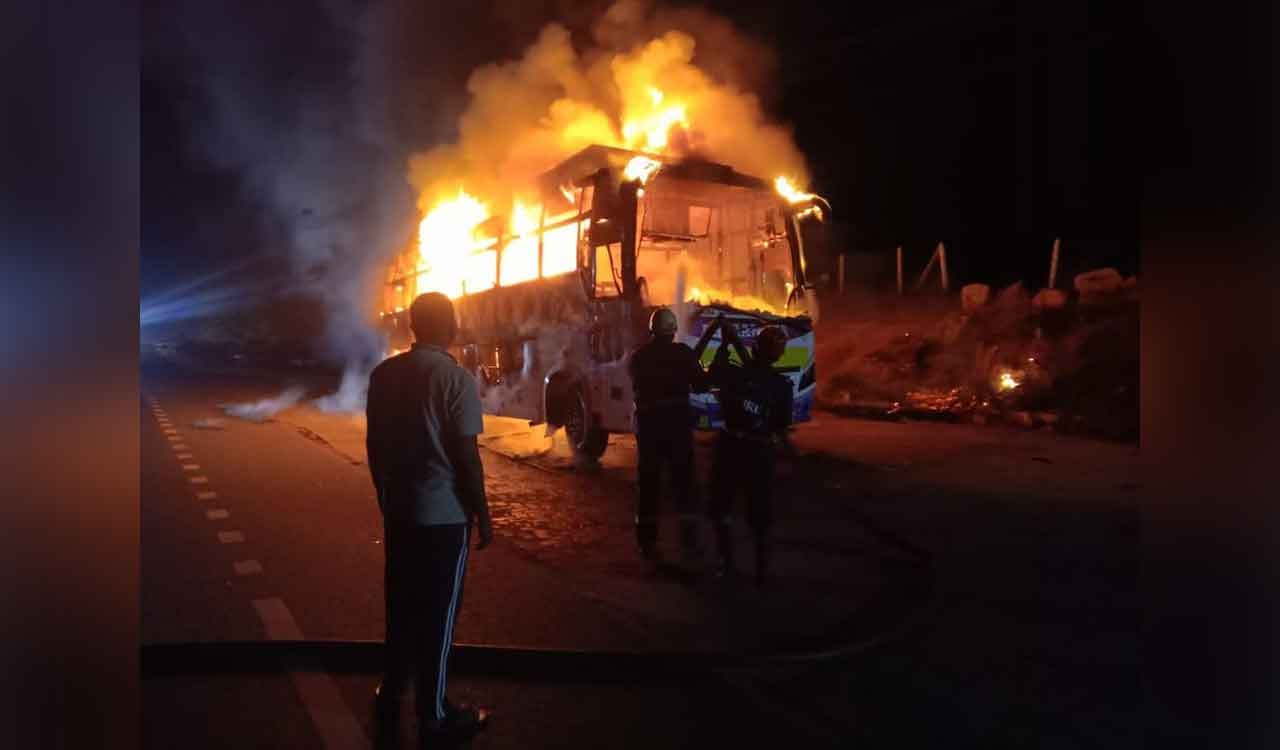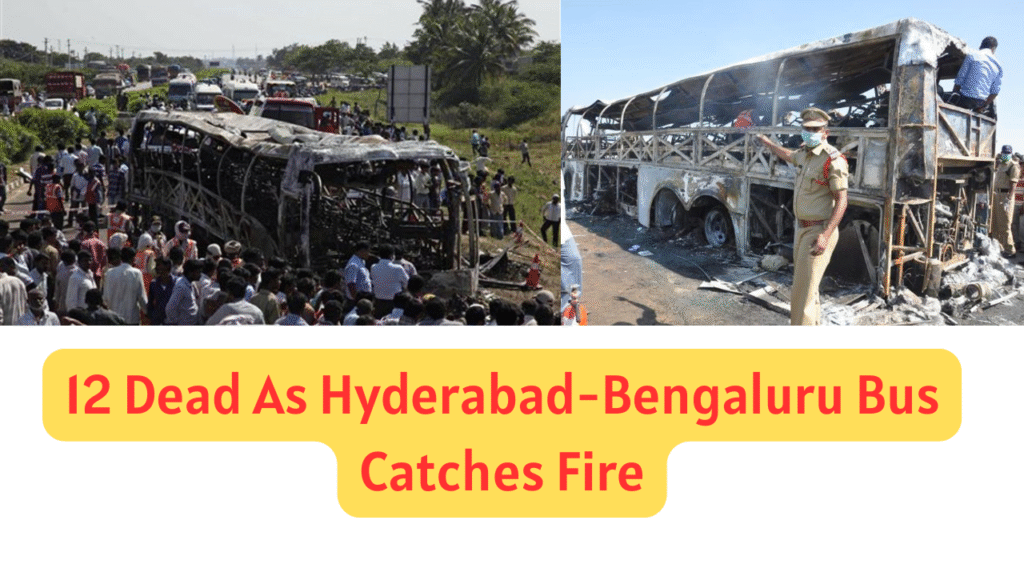In the predawn hours of October 24, 2025, a horrifying incident unfolded on National Highway 44, near Chinna Tekuru village in Kurnool district of Andhra Pradesh. A private sleeper bus, running from Hyderabad to Bengaluru, ended in tragedy when it collided with a two-wheeler and subsequently caught fire — within minutes the vehicle was ablaze, and a large number of passengers became victims of the inferno.

According to police and news agency reports, the bus was carrying around 40 to 42 passengers when the mishap occurred at about 3:30 a.m.. The bus was reported to be an air-conditioned “Volvo” coach belonging to Kaveri Travels, operating the Hyderabad-Bengaluru route. Eyewitnesses and officials say that the two-wheeler became trapped under the front of the bus, which is believed to have caused sparks and set off the blaze in the front section of the vehicle.
As the fire erupted, it spread with terrifying rapidity — burning through the bus in just a few minutes. Passengers, many of whom would have been asleep at the time, had precious little time to react. An official from the Kurnool police told media that because the bus was AC-equipped, the side windows were sealed and the only possible exit for many was to break the window panes — a feat only some managed. According to reports, about twenty people jumped out of the bus after breaking windows, but many others were either trapped or succumbed to the flames.
In the immediate aftermath, official tolls vary: some sources report at least 12 dead and more missing, while others raise the figure to 20 or more fatalities, with dozens injured.Identification of the deceased is proving challenging, as many bodies were badly charred. The injured have been rushed to hospitals in Kurnool, and forensic and transport department teams have been deployed to investigate the underlying causes of the tragedy.
Sequence of events & crash dynamics
According to investigations and witness accounts, the bus left Hyderabad around midnight, bound for Bengaluru. Around 3:30 a.m., just after passing Chinna Tekuru on NH-44, the bus collided with a motorbike which apparently got stuck beneath the bus’s front section. The police speculate that this entrapment caused sparks, igniting combustible materials and leading to the rapid fire the blaze started at the front and engulfed the entire vehicle within minutes: “It burnt within two to three minutes,” one local politician expressed. Rain in the area at the time is also reported to have complicated the rescue efforts.
One of the critical contributing factors appears to have been the jammed or inaccessible emergency exit and the sealed nature of windows in the AC coach configuration. Passengers who managed to break out early likely survived; however, those who couldn’t were trapped as the fire roared. Heavy smoke, intense flame and structural constraints combined to make escape—especially for sleeping passengers—extremely difficult.
Rescue and relief operations
Emergency services were alerted and rushed to the site, but by the time they arrived the bus was already almost completely destroyed. The charred remains of the vehicle were brought under control, but the delay, rapid spread of fire and difficult terrain all hampered the rescue. Local residents, police and a forensic team (FSL) were mobilized to search for missing persons and recover bodies.The presence of heavy rain, reported in the region, further slowed firefighting and extraction efforts. The transport department announced that records of the bus’s fitness, emergency exits and maintenance are being reviewed
Government response & public reaction
In the wake of the tragedy, condolences poured in. The Prime Minister of India, Narendra Modi, expressed his sorrow and announced ex-gratia compensation of ₹2 lakh for each deceased and ₹50,000 for the injured from the Prime Minister’s National Relief Fund (PMNRF). The President, Droupadi Murmu, also offered her heartfelt condolences. The Chief Minister of Andhra Pradesh, N. Chandrababu Naidu, described the incident as “devastating” and pledged full government support for relief, treatment of injured and assistance to bereaved families The state transport minister has also ordered a safety audit of all long-haul AC buses, especially those operating on high-speed highways.
Underlying issues & safety concerns
This accident has thrown up serious questions about road and passenger safety in high-speed inter-city bus travel:
- Bus design and emergency exits: The fact that the bus was AC and sealed windows meant escape was harder. The rapid burn also suggests that combustible materials inside the bus or in its design made the fire spread faster.
- Collision with smaller vehicle: A two-wheeler colliding and getting trapped beneath a large coach is a known risk on highways, but it prompts deeper questions about driver vigilance, road conditions, speed, and signage.
- Rescue preparedness: The speed at which fire engulfed the bus (within 2-3 minutes per witness) left little time for reaction. This underscores the need for regular drills, proper marking of exits, functional fire extinguishers, and accessible escape routes.
- Regulation enforcement: The transport department’s review of the bus’s compliance record may reveal whether service vehicles are being inspected adequately, whether driver fatigue or route-timing was a factor, or if safety features were compromised.
- Road & weather conditions: Rain at the time and early morning darkness may have contributed to reduced visibility, longer stopping distances, or slippery surfaces.

Impact & human cost
For the families of the victims, the loss is immeasurable. Many victims were reportedly sleeping during the journey, unaware of the impending disaster. The psychological trauma on survivors, first-responders and the wider travelling public will be significant. Locally, the highway (NH-44) experienced delays and congestion as the accident site was processed and vehicles diverted. The shockwaves of this incident will likely affect passenger behaviour, bus industry protocols, and regulatory scrutiny.
A wake-up call
While specific final numbers (fatalities, missing) are still being confirmed, the incident is already being labelled as one of the most severe bus fire tragedies in recent memory on this route. It serves as a grim reminder that even routine journeys can turn into nightmares when multiple small factors—collision, material design, emergency access, speed—align in the wrong way.
What’s next?
- Authorities will complete recovery of bodies, identification (some via DNA because of severe burn injuries), and counselling of bereaved families.
- A forensic investigation will determine the exact cause of ignition, fire spread dynamics, bus compliance with safety standards (seat material fire retardancy, emergency exit functionality, driver rest hours etc.).
- The transport department may mandate stricter norms for AC long-haul buses: more and better-marked exit windows, fire suppression systems, automatic shut-off valves, and compulsory drills for staff.
- Road safety agencies may revisit the hazard posed by buses overtaking slower vehicles, interactions with two-wheelers, and viability of dedicated bus lanes or slow-moving vehicle warnings on highways like NH-44.
- Public pressure will likely mount on travel operators to maintain transparency about safety records, and on regulators to enforce audits and unannounced inspections.

Conclusion
The accident on the Hyderabad-Bengaluru route near Kurnool in Andhra Pradesh is a tragedy of immense proportions: a bus that should have carried passengers safely to their destination instead became a death trap within minutes. The loss of at least 12 people (and possibly many more) is heart-breaking. This incident shines a glaring spotlight on issues of road safety, bus design and emergency preparedness. As investigations unfold and families mourn, the broader lesson stands clear: without robust safety mechanisms, even well-planned journeys can end in disaster.
The travel community, bus operators and regulatory bodies must now take heed, and ensure that no more lives are sacrificed on our highways through avoidable negligence or oversight.


